 We didn’t set out to visit Ireland as part of our trip to the Winter Olympics in Sochi. But, instead of paying for round-trip air from Kauai to a European hub such as Frankfurt or Amsterdam, it was a no-brainer to take advantage of a six-day package – air, accommodations and car – that cost the same.
We didn’t set out to visit Ireland as part of our trip to the Winter Olympics in Sochi. But, instead of paying for round-trip air from Kauai to a European hub such as Frankfurt or Amsterdam, it was a no-brainer to take advantage of a six-day package – air, accommodations and car – that cost the same.
We approached the idea of driving in Ireland with a little trepidation. Friends who had done it reassured us with helpful hints: “follow taillights; if you’re looking at headlights you’re wrong.” We knew certain aspects would be extremely disorienting: right turns into oncoming traffic, steering wheel on the right, etc. A friend who’d moved there several years before told us it didn’t take long for her to get used to driving in Ireland. We hoped for the best!
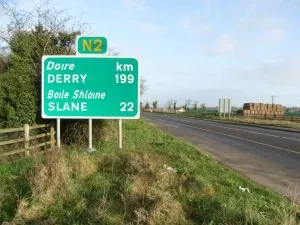 Observations:
Observations:
First of all, the Irish like their speed! People drive fast! And they’re seemingly reckless! But really, they’re just used to smaller roads, hairpin turns, limited visibility, and sharing tight spaces. If you’d grown up with these conditions, you’d be driving this way as well.
Typical speed limits are equivalent to those in the U.S., but measured with the metric system, as are distances. This was pretty easy to get used to, not that everyone complied with speed limits. I learned that pretty much anything goes on the larger highways.
 Pedestrians do not necessarily have the right of way. This was very disorienting because in Hawaii, and subsequently we found in Liechtenstein and Germany, you stop no matter what for a pedestrian. In Ireland, if you’re walking, you’ll wait for the “go” light (a little green person) at intersections that have traffic lights. Sometimes people wait on the median or at a divider in the middle of intersections. It was hard for me to see a mother with a pram standing in the middle of traffic! My default was to stop for them based on my Hawaii norm. After a little friendly honking from behind, I learned not to do this.
Pedestrians do not necessarily have the right of way. This was very disorienting because in Hawaii, and subsequently we found in Liechtenstein and Germany, you stop no matter what for a pedestrian. In Ireland, if you’re walking, you’ll wait for the “go” light (a little green person) at intersections that have traffic lights. Sometimes people wait on the median or at a divider in the middle of intersections. It was hard for me to see a mother with a pram standing in the middle of traffic! My default was to stop for them based on my Hawaii norm. After a little friendly honking from behind, I learned not to do this.
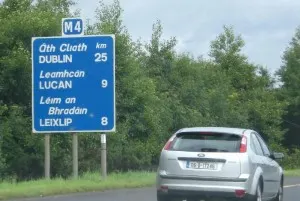 Road signs in Ireland are in English and Irish. This is charming and confusing at the same time. Additionally, oncoming points ascend in terms of distance, so you’re looking at the bottom of the sign for your next destination. Completely the opposite as we were used to.
Road signs in Ireland are in English and Irish. This is charming and confusing at the same time. Additionally, oncoming points ascend in terms of distance, so you’re looking at the bottom of the sign for your next destination. Completely the opposite as we were used to.
 Roundabouts are extremely efficient for intersections without traffic lights. But they’re still scary if you’re not used to them. They gave me the same feeling I had when trying to gauge when to cut in to the jump rope on the playground in grade school.
Roundabouts are extremely efficient for intersections without traffic lights. But they’re still scary if you’re not used to them. They gave me the same feeling I had when trying to gauge when to cut in to the jump rope on the playground in grade school.
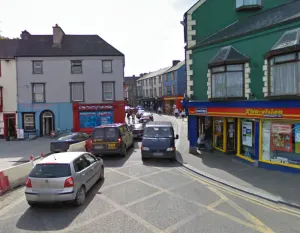 As a driver, you’ll be hugging the center line in roads with two lanes. On smaller roads and streets, and there are many of these, you’ll travel in the center moving over only if there’s an oncoming vehicle. Many tiny streets in older areas will have vehicles parked on both sides in both directions. This is disorienting because they’re not necessarily one way streets; it’s more like find a parking spot and grab it no matter which direction you’re facing. And pull your rearview mirror in so it doesn’t get clipped.
As a driver, you’ll be hugging the center line in roads with two lanes. On smaller roads and streets, and there are many of these, you’ll travel in the center moving over only if there’s an oncoming vehicle. Many tiny streets in older areas will have vehicles parked on both sides in both directions. This is disorienting because they’re not necessarily one way streets; it’s more like find a parking spot and grab it no matter which direction you’re facing. And pull your rearview mirror in so it doesn’t get clipped.
On Motorways (like our freeways), the slow lane is on the left, and the fast lane is next to the divider or median (the reverse from what we are used to). I thought I was in the slow lane, driving like the old lady that I am, only to be set upon by an annoyed person in my rearview mirror, flashing their lights for me to get over. Lesson learned.
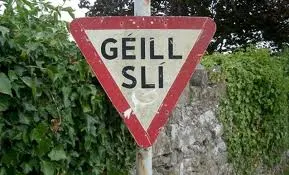 Rearview mirror habits will change. The center rearview mirror is a glance to the left. I found my eyes were trained to look up and to the right, and it was strange not to find it where they thought it should be.
Rearview mirror habits will change. The center rearview mirror is a glance to the left. I found my eyes were trained to look up and to the right, and it was strange not to find it where they thought it should be.
Yellow crosshatches painted in the roadway are indicators that you shouldn’t stop there while obeying a traffic signal. They’re space for folks who are turning into the roadway from either side. Lane divides and passing permissions are painted in white in the center (you may be used to yellow in your state).
 Cute colloquialisms such as “Traffic calming ahead” and “Slippy if wet” are amusing.
Cute colloquialisms such as “Traffic calming ahead” and “Slippy if wet” are amusing.
Car park kiosks are pay as you go, get a receipt and place it on the driver’s dash. These apply in parking lots or streetside instead of meters. We waited to watch a gentleman work the kiosk so we’d know what to do; turns out he was from Connecticut and wanted to watch us! While we laughed at our mutual ineptitude, a nice local lady came up and gave us a ticket with unused time on it.
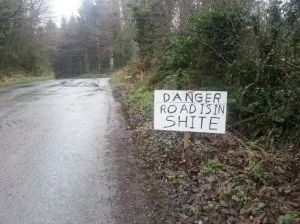 Sometimes the Irish take matters into their own hands, utilizing the famous sense of humor to warn of conditions! We learned to look for these homemade signs as well as the unique brown and white signs that indicated points of interest. By week’s end, I was sounding out what the sign said in the way I’d imagine an Irish speaker would be saying it: with a lilting brogue and a twinkle in the eye.
Sometimes the Irish take matters into their own hands, utilizing the famous sense of humor to warn of conditions! We learned to look for these homemade signs as well as the unique brown and white signs that indicated points of interest. By week’s end, I was sounding out what the sign said in the way I’d imagine an Irish speaker would be saying it: with a lilting brogue and a twinkle in the eye.
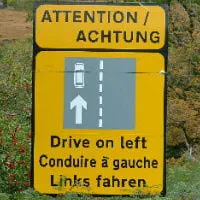 All in all, other than a couple of times when Pete screamed, “WRONG! WRONG!” when I inadvertently turned into traffic, and nighttime driving on narrow, hilly secondary roads with oncoming vehicles, we managed. That we emerged unscathed isn’t quite a miracle, but it’s close!
All in all, other than a couple of times when Pete screamed, “WRONG! WRONG!” when I inadvertently turned into traffic, and nighttime driving on narrow, hilly secondary roads with oncoming vehicles, we managed. That we emerged unscathed isn’t quite a miracle, but it’s close!
Have you any experience driving in Ireland or other countries as someone who is used to driving on the right? Please share!
Tips for Trip Success
Book Your Flight
Find an inexpensive flight by using Kayak, a favorite of ours because it regularly returns less expensive flight options from a variety of airlines.
Book Your Hotel or Special Accommodation
We are big fans of Booking.com. We like their review system and photos. If we want to see more reviews and additional booking options, we go to Expedia.
You Need Travel Insurance!
Good travel insurance means having total peace of mind. Travel insurance protects you when your medical insurance often will not and better than what you get from your credit card. It will provide comprehensive coverage should you need medical treatment or return to the United States, compensation for trip interruption, baggage loss, and other situations.Find the Perfect Insurance Plan for Your Trip
PassingThru is a participant in the Amazon Services LLC Associates Program. As an Amazon Associate I earn from qualifying purchases.
To view PassingThru’s privacy policy, click here.

Bruff, Ireland: Visiting Lough Gur and The Old Bank B&B - Passing Thru
Tuesday 25th of March 2014
[…] Getting Used to Driving in Ireland […]
Mike
Saturday 25th of January 2014
Only as a passenger in taxis in Scotland back in the 70s. Narrow roads around Holy Loch and Dunoon were quite interesting during the day when sober. The inebriated ride back to the pier along the same roads was a different story! (Sub sailors do it deeper! -- never was quite sure what it was. ;) )
Betsy Wuebker
Saturday 25th of January 2014
Hahaha! Yes, "interesting" is a good way to put it. White knuckles and all!